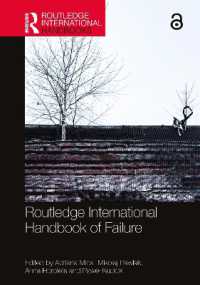Full Description
Learn how to design history lessons that foster students' knowledge, skills, and dispositions for civic engagement. Each section of this practical resource introduces a key element of civic engagement, such as defending the rights of others, advocating for change, taking action when problems are observed, compromising to promote reform, and working with others to achieve common goals. Primary and secondary sources are provided for lessons on diverse topics such as the Alice Paul and the Silent Sentinels, Samuel Gompers and the American Federation of Labor, Harriet Tubman, Reagan and Gorbachev's unlikely friendship, and Lincoln's plan for Reconstructing the Union. With Teaching History, Learning Citizenship, teachers can show students how to apply historical thinking skills to real world problems and to act on civic dispositions to make positive changes in their communities.Book Features:
Ready-to-use lessons on important historical topics that are likely already part of the history curriculum.
Materials that allow teachers flexibility in the way lessons are designed.
Lessons aligned with important civic engagement themes, including ideas for additional historical topics that are useful to teach similar themes.
Strategies to help teachers facilitate the transfer of thinking skills and concepts (such as empathy, corroboration, and historiography) into the realm of civic engagement.
Background knowledge customized for use with the documents included in the book.
Contents
Foreword Laura Wakefield
Introduction
1. A New Vision of History Teaching
Knowledge
Skills
Dispositions
Section and Chapter Organization
Knowing and Doing Citizenship
Part I: Defending Civil Rights: Looking Out for One Another
2. John Adams and Josiah Quincy Jr., and the Boston Massacre Trial: Defending Others' Rights
Students' Background Knowledge
Historical Background for Teachers and Students
Historical Thinking Skills: Corroboration
Lesson Ideas
Instructional Materials
3. Harriet Tubman and the Underground Railroad
Students' Background Knowledge
Historical Background for Teachers and Students
Historical Thinking Skills: Historiography
Lesson Ideas
Instructional Materials
Part II: Collaborative Problem Solving: Making a Difference by Coming Together
4. Committees of Correspondence
Students' Background Knowledge
Historical Background for Teachers and Students
Historical Thinking Skills: Contextualization
Lesson Ideas
Instructional Materials
5. Samuel Gompers and the American Federation of Labor
Students' Background Knowledge
Historical Background for Teachers and Students
Historical Thinking Skills: Historical Empathy
Lesson Ideas
Instructional Materials
Part III: Compromise: Sacrificing for the Common Good
6. The Great Compromise
Students' Background Knowledge
Historical Background for Teachers and Students
Historical Thinking Skills: Historical Perspective Taking
Lesson Ideas
Instructional Materials
7. Compromise and the Civil Rights Act of 1964
Students' Background Knowledge
Historical Background for Teachers and Students
Historical Thinking Skills: Change and Continuity
Lesson Ideas
Instructional Materials
Part iv: Getting along with Adversaries
8. Lincoln's Plan for Reconstruction: Binding a Nation's Wounds
Students' Background Knowledge
Historical Background for Teachers and Students
Historical Thinking Skills: Ethical Judgment
Lesson Ideas
Instructional Materials
9. Reagan and Gorbachev: Adversaries and Friends
Students' Background Knowledge
Historical Background for Teachers and Students
Historical Thinking Skills: Argumentative Writing
Lesson Ideas
Instructional Materials
Part V: Demonstrating Disapproval: Courageously Taking a Stand
10. Alice Paul and the Silent Sentinels: Demonstrating Disapproval
Students' Background Knowledge
Historical Background for Teachers and Students
Historical Thinking Skills: Photograph Analysis
Lesson Ideas
Instructional Materials
11. Tommie Smith, John Carlos, and the 1968 Olympic Protests: Demonstrating Disapproval
Students' Background Knowledge
Historical Background for Teachers and Students
Historical Thinking Skills: Contextualization
Lesson Ideas
Instructional Materials
Part VI: Civil Disobedience: When All Else Fails
12. Susan B. Anthony and the Election of 1872: A Model of Civil Disobedience
Students' Background Knowledge
Historical Background for Teachers and Students
Historical Thinking Skills: Identifying Historical Significance
Lesson Ideas
Instructional Materials
13. James Farmer Jr. and the Freedom Riders: Models of Civil Disobedience
Students' Background Knowledge
Historical Background for Teachers and Students
Historical Thinking Skills: Sourcing
Lesson Ideas
Instructional Materials
References
Index
About the Author







